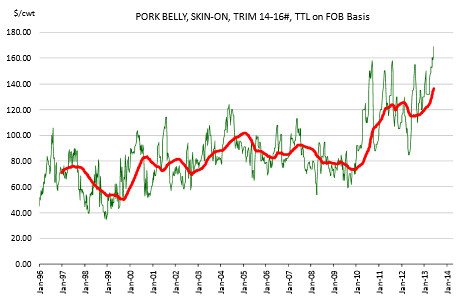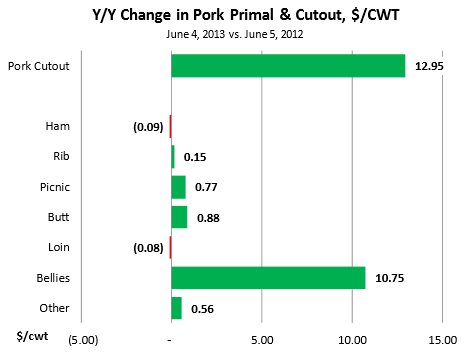



CME: Demand for Bacon Saves Hog Prices this Spring
US - The insatiable demand for bacon has proved to be the saving grace for hog prices so far this spring, write Steve Meyer and Len Steiner.USDA quoted the belly primal, a calculated index based on the selling price of various belly products, at $166.72/cwt, $67.87/cwt or 69% higher than the same time a year ago and an all time record high. With the introduction of the new mandatory price reporting system, the quotes for 14-16# skin on bellies, long used as a benchmark for belly prices, have been more limited and USDA again did not quote the skin on bellies in its report on Tuesday.
However, the price of 9-13# derind bellies on Tuesday was $207.22/cwt and when converted at a 0.815 ratio, it indicates a 14-16# equivalent price of about $168/cwt. The reason for the conversion is to get some historical perspective for the surge in belly prices in the last 20 years. The 52-wk moving average for belly prices is currently approaching $140/cwt, about 65% higher than the long run average for the period 2000-2010.
As the chart below shows, there has been a distinct shift in the price of bellies in the last three years even as hog slaughter has been trending higher. And the surge in the price of pork bellies, which account for about 16% of the entire carcass, has dramatically increased overall pork values. The pork cutout was quoted by USDA at $95.76/cwt, $12.95/cwt or 16% higher than a year ago. Higher pork belly prices accounted for $10. 75 of the higher cutout values. The rise in the belly value is the difference in hog prices trading in the mid 80s rather than the mid 90s as they are today. It is the difference between significant losses or getting close to breaking even.


So why the recent surge in belly prices? Some argue that the introduction of the Mandatory Price Reporting system now captures all the various prices paid for bellies while in the past the belly primal was mostly a constructed number based on the 14-16# skin on benchmark. While this argument may explain a few cents of difference, it does not account for the big 65 cent surge we have seen recently
We think that in part the more recent increase in the price of bellies has to do with foodservice ordering patterns. Two thirds of the belly supplies is used at foodservice. High corn prices in the last two and a half years have caused a lot of worry among foodservice operators. With bacon a staple of foodservice menus in recent years, the worry was that sharp cutbacks in pork supplies could lead to significant price inflation. Large foodservice operators appear to have contracted a good portion of the bellies, especially for the April - September period, which is normally the period when retail demand also improves.
With a large part of the supply for the period already spoken for, those that need to buy in the spot market now have to bid ever higher prices to secure product. And keep in mind that not all those forward purchases are priced off lower levels. Some forward purchases are done on a sheet deal, which means they are priced off the spot market. There is little chance that we will see bacon disappearing from foodservice menus anytime soon. A study that is a bit dated now shows that the number of bacon menu items rose from a little over 1700 in 2000 to about 2700 in 2009 and it is likely well over 3000 today. This is several times higher than the number of other pork items in the restaurant menu. And with chicken breasts once again a favorite foodservice feature, the value of flavor enhancers, such as bacon, is hard to overstate.








